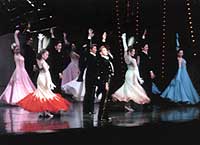|
|
|||||||
|
|
|||||||
|
|||||||
| | Web Japan >>| Trends in Japan >> | Arts & Entertainment >> | 90 Magical Years of Takarazuka | |
|
90 MAGICAL YEARS OF TAKARAZUKA All-Female Revue Celebrates Anniversary (March 17, 2004) A century ago, Takarazuka was just a small village near Osaka. Now it is a thriving show-business hub. This area owes its popularity in large part to the Takarazuka Revue, popularly known as Takarazuka, which is based here. Takarazuka, the world's only all-female musical performance company, has long been established as a uniquely Japanese form of popular entertainment. This year the company marks its ninetieth anniversary of its first performance.
Female Performers in Male Roles The biggest distinguishing feature of Takarazuka, and one of the main sources of its popularity, is the fact that all of the performers onstage, even the ones in male roles, are female. These women play their parts so convincingly that many people believe they surpass male actors in terms of their expressions of masculine appeal. This practice of one gender playing parts of the other is seen in mirror image in Kabuki, an all-male form of theater in which the actors in the female roles succeed in exuding more feminine allure than actual women. The Takarazuka Revue was established in 1913 by Kobayashi Ichizo, the founder of Hankyu Railway. Kobayashi hit upon the idea of building entertainment facilities to boost passenger numbers on his trains. As the location for this project he chose Takarazuka, which in those days was just a village with a few hot-springs inns. Back in 1913, forming an all-female performance troupe was no mean feat. With a few exceptions, such as acrobats, the very idea of a woman performing onstage was unheard of. In the hope of putting together a company of girls from good families, Kobayashi set up the Takarazuka Music School, which was billed as an institution for educating women to be "good wives and wise mothers" while also training them in the performing arts. Students of the school became performers in the revue troupe upon graduation. To this day, the Takarazuka Revue is considered a school, and its members are referred to as students. The company's motto is Kiyoku tadashiku utsukushiku ("Pure, proper, beautiful").
A "School" with an Exclusive Entrance Policy If a girl is lucky enough to get in, she enters a rigorous training program that encompasses singing, dancing (both Japanese and Western), and acting. After two years of training five days a week from 9:00 in the morning until 5:00 in the evening, all members of the class enter the Takarazuka Revue, where the stage that most people can only dream of awaits them. The line dance is a rite of passage for the freshmen entering the troupe. For 40 people to line up in a single row and perform without a single misstep, they have to practice six hours a day for over a month. After this hard training period, each student is assigned to one of five troupes: Hana (Flower), Tsuki (Moon), Yuki (Snow), Hoshi (Star), or Sora (Cosmos). Their lives as professional performers begin here. Each of the five troupes alternates between two bases: the Takarazuka Grand Theater in Takarazuka, and the Tokyo Takarazuka Theater in Tokyo. Each run generally lasts for a month and a half. The groups also perform in provincial Japanese cities, as well as in other countries. All of the troupes remain in rotation at all times. Their program consists of musicals, revues, and the famous line dance. Each group has its own superstar performers in both male and female roles. These top stars always play the lead roles in musicals. In a troupe of 70 to 80 performers, competition for the top echelons is fierce. The path to becoming a seasoned "male" performer is particularly long and arduous, as evidenced by a phrase used by members of the company: "otokoyaku junen" ("10 years to a male role"). The popularity of Takarazuka rests on the backs of the "male" superstars. They must sing and dance in a masculine manner and be strong enough to lift the performers playing the female roles with ease. It is no simple matter for a pretty young girl to master the skills needed to play a male role convincingly. The process involves diligent study (with film love scenes serving as one point of reference) and practice. In the performances, the male characters express their love through impassioned speeches that most men would be too self-conscious to make. Yet such flowery praise is just what many woman want to hear, and therein lies the secret to Takarazuka's popularity: Women make up the overwhelming majority of Takarazuka audiences.
Special Anniversary Events Takarazuka Revue Hankyu Railways Copyright (c) 2004 Web Japan. Edited by Japan Echo Inc. based on domestic Japanese news sources. Articles presented here are offered for reference purposes and do not necessarily represent the policy or views of the Japanese Government. |
SMALL-THEATER OPERA (August 17, 2000) |
|
|



